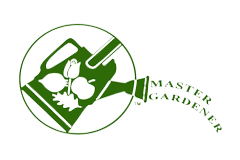Catherine Kavassalis – Halton Master Gardeners
If you want to help native pollinators, stick to mostly native species. “Plant a variety of plants, biased towards native and near-native species with a selection of exotics to extend the flowering season.”
There are many types of pollinators and they require a diversity of plants that can provide pollen and nectar throughout the growing season, and some like moths and butterflies may require foliage at other stages of development.
• Bees – Bright colours (except red which bees cannot see)
• Butterflies – Bright colours including red with faint sweet scents and a landing pad
• Moths – Night blooming flowers (typically white) with strong, thick sweet smells
• Flies – All of the above plus flowers with the odour and colour of rotting fruit or dung
• Beetles – Strongly fruity white or green flowers
Include Keystone Plants in your gardens. These support native bee pollinators that are most at risk. The top native host plants for bee pollen specialist in the Eastern Temperate Region include:
- sunflower (Helianthus spp),
- goldenrods (Solidago spp),
- asters (Symphyotrichum spp),
- black eyed susan (Rudbeckia spp),
- tickseed (Coreopsis spp),
- beggartick (Bidens spp),
- native thistle (Cirsium spp.),
- willow (Salix spp),
- blueberry (Vaccinium)
- cranberry, (Oxycoccus)
- deerberry (Vaccinium spp),
- fleabanes (Erigeron spp),
- ironweed (Vernonia spp),
- Goldentop (Euthamia spp),
- Prairie clover (Dalea spp),
- Evening primrose (Oenothera spp),
- Coneflower (Echinacea spp),
- Blanketflower(Gaillardia spp),
- Sneezeweed (Helenium spp),
- False sunflower (Heliopsis spp),
- Dogwood (Cornus spp)
Pollinators must be provided nesting habitat and resources if they are to survive.
- They may nest in the foliage or stems of plants, in wood or in cracks in stone or in soil. Think about that when creating your garden.
- See Attracting Pollinators to Your Garden Using Native Plants https://www.fs.fed.us/…/doc…/AttractingPollinatorsV5.pdf
Phenology – Plants must flower at the right time to support the life cycle of the pollinator. Think about plants for each part of the growing season. A University of Michigan Study suggest plants like:
- Early Season: Strawberry (Fragaria virginiana), Golden Alexander (Zizia aurea), Penstemon (Penstemon hirsutus), Lanceleaf coreopsis (Coreopsis lanceolata), Shrubby cinquefoil (Dasiphora fruticosa), Dogbane (Apocynum cannabinum).
- Mid-Season: Smooth rose (Rosa bland), Vervain (Verbena stricta or V hastata), Milkweeds, (Asclepias incarnata , A. tuberosa ..), Culver’s root (Veronicastrum virginicum), Ratibida pinnata (Gray headed coneflower), Amorpha canescens (Lead plant), Nodding onion (Allium cernuum), Spiraea alba (Meadowsweet).
- Late Season: Yellow Giant Hyssop (Agastache nepetoides), Bee Balm (Monarda fistulosa, M. didyma, M. punctata, Missouri Ironweed, Vernonia missurica, Cup Plant, Silphium perfoliatum), Boneset (Eupatorium perfoliatum), Great Lobelia (Lobelia siphilitica), Sunflower (Helianthus spp), Hairy bush clover (Lespedeza hirta), Blazing star, (Liatris aspera, L. spicata), Goldenrod (Oligoneuron spp., Solidago spp), Aster, Symphyotrichum spp).
Cultivars of native species are usually less attractive to pollinators, though there are exceptions, e.g. Culver’s Root – Veronicastrum virginicum ‘Lavendelturm’, Phlox paniculata: ‘Jeana’; ‘Dick Weaver’ ‘Delta Snow’ ‘Lavelle’ ‘Robert Poore.’
Exotics and annuals that are long blooming can provide beauty and pollinator support when nothing else is available. Recommended species include: Bighead knapweed Centaurea macrocephala, Dahlia (open types like ‘Bishop of York,’ ‘Esther,’ or ‘Bishop of Llanda’), Mexican sunflower (Tithonia rotundifolia).
Grasses and sedges can form an important matrix for your pollinator garden. They provide, shelter, protection from predators and for some pollinators food. Attractive native grasses include: Big bluestem (Andropogon gerardii), Bottle brush (Elymus hystrix), Wood Millet (Milium effusum), Switch grass (Panicum virgatum), Little bluestem (Schizachyrium scoparium), Indian grass (Sorghastrum nutans). Sedge species worth considering: Carex albicans, C. bromoides, C. crinata, C. eburnea, C. grayii, C. grisea, C. pensylvanica, C. plantaginea, C. sprengelii, C. vulpinoidea. Most sedge species prefer shady moist conditions.
More ideas
Pollinator Plants for the Great Lakes Region, The Xerces Society https://xerces.org/publications/plant-lists/pollinator-plants-great-lakes-region
References:
- W. Gold. 2008. Plant Selection, Forms & Sources. University of Washington Restoration Ecology Network (UW-REN) Capstone. http://courses.washington.edu/…/Plant_selection_110708…
- M. Vaughan and S. Black (2006) USDA National Agroforestry Center. AF Note-34: Enhancing Nest Sites for Native Bee Crop Pollinators. https://www.plants.usda.gov/…/Enhancing_Nest_Sites_For…
- Vaudo AD, et al. (2015) Patch HM: Bee nutrition and floral resource restoration. Current Opinion in Insect Science 10:133-141.
- Fowler, J. & Droege, S. (2016). Specialist bees of the Mid-Atlantic and Northeastern United States. Xerces Society http://jarrodfowler.com/specialist_bees.html
- http://www.xerces.org/…/nests_for_native_bees_fact…
- Moisset, B., Buchmann, S (2012) Bee basics: An introduction to our native bees. Washington, DC: USDA Forest Service and Pollinator Partnership. https://www.fs.fed.us/…/pollina…/documents/BeeBasics.pdf
- Salisbury, A., et al. (2015) Enhancing gardens as habitats for flower-visiting aerial insects (pollinators): should we plant native or exotic species?. J Appl Ecol, 52: 1156–1164.
- Create a pollinator-friendly garden for the birds, bees and butterflies https://davidsuzuki.org/…/create-pollinator-friendly…/
- Tuell J.K., Fiedler A.K., Landis D. & Isaacs R. (2008) Visitation by wild and managed bees (Hymenoptera: Apoidea) to eastern US native plants for use in conservation programs. Environmental Entomology, 37, 707-718).
- More resources from MSU are online: http://www.canr.msu.edu/nativepl…/resources/teaching_tools
- Tallamy, D. 2007. Bringing Nature home. Timber press. http://enst.umd.edu/…/_docsTable%201%20from%20Doug…
- Heather Holm has published a helpful list of Native Trees and Shrubs for Pollinators online: https://www.pollinatorsnativeplants.com/plant-lists….
- Forest Gene Conservation Assoc. http://fgca.net/
Online Resources:
• Native Plants for Pollinators, Credit Valley Conservation: https://cvc.ca/…/17-uo-nativeplantsforpollinators… • Selecting Plants for Pollinators – Lake Erie Lowlands- Pollinator Partnership http://www.pollinator.org/…/LakeErieLowlands.ver8.hires… • Pollinator Friendly Plants for Northeast US – NRCS – USDA https://www.nrcs.usda.gov/…/publications/nypmctn11164.pdf
• Attracting Pollinators to Your Garden US Forestry Service: https://www.fs.fed.us/…/AttractingPollinatorsEasternUS…
• Evergreen Native Plant Database https://nativeplants.evergreen.ca/
• ‘Garden for Life’ Plant List, Oakville Horticultural Society oakvillehort.org
• Help Native Bees, Conservation Halton: http://www.conservationhalton.ca/help-native-bees
• Pollination Guelph https://www.pollinationguelph.ca/
• Xerces Society https://xerces.org/
• Snetsinger Butterfly Garden Designs: http://www.snetsingerbutterflygarden.org/plant-selection…
Attracting Pollinators to Your Garden Using Native Plants https://www.fs.fed.us/…/doc…/AttractingPollinatorsV5.pdf
Cover Image: Biodiversity Gardening

